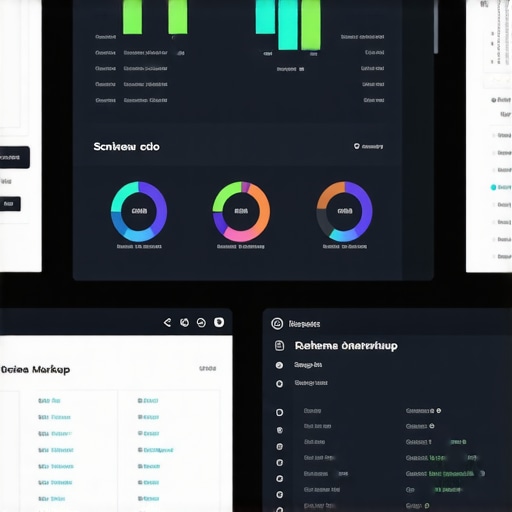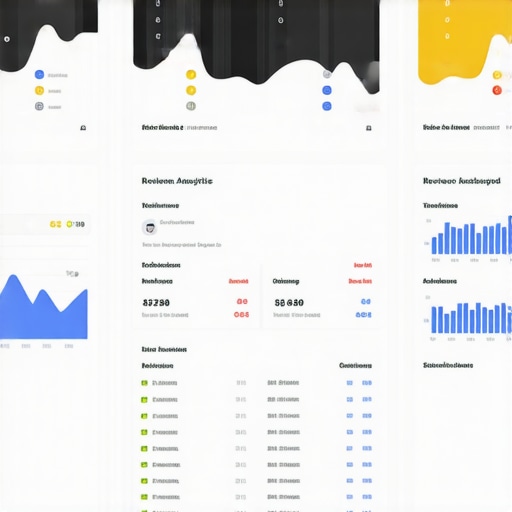Ready to Take Your Google My Business Game to the Next Level?
Imagine this: you’re a local business owner, staring at the Google search results, wondering why some competitors always seem to outrank you. The secret sauce isn’t just luck—it’s strategic mastery of local SEO and GMB optimization. Welcome to the wild world of GMB Domination, where proven tactics can propel your business to the top of local searches in 2024.
Why Is GMB Still the Kingpin of Local SEO?
Google My Business remains an indispensable tool for local visibility. Despite the rise of social media and other marketing channels, 78% of local mobile searches lead to an offline purchase, according to Moz. Think about it: the map pack is the prime real estate for attracting nearby customers, but only if you know how to optimize your listing effectively.
What Are the Secret Ingredients to GMB Success?
Is Your Business Listing Really Optimized for Local Stardom?
Optimization isn’t just about filling in your address and phone number. It’s about crafting a compelling profile that Google and customers love. This includes accurate NAP data, high-quality images, and engaging business descriptions. Don’t forget to sprinkle relevant keywords naturally, like ‘best pizza in Brooklyn’ or ‘top-rated plumber in Dallas.’
How Can You Outrank Your Competition in 2024?
While the basics matter, advanced strategies make the real difference. Think about leveraging local citations, managing reviews diligently, and utilizing Google Posts to keep your audience engaged. For example, regularly updating your GMB with fresh offers or news can signal activity to Google, boosting your ranking.
Are You Ready to Dominate Local Search and Leave Competitors in the Dust?
If you’re eager to see tangible results, check out our comprehensive guide to GMB ranking success. Remember, consistent effort and strategic tweaks are your best friends in this game.
As you embark on this journey to local SEO excellence, stay curious, adapt to changes, and don’t shy away from experimenting with new tactics. The top spot isn’t reserved for luck—it’s earned through knowledge, persistence, and a bit of that good old SEO savvy.
Unlocking the Hidden Gems of Google My Business Optimization
While many businesses focus on the basics, such as verifying their listing and adding accurate contact details, the true power lies in deploying advanced strategies that Google values highly. For example, leveraging advanced GMB optimization techniques can propel your listing to the forefront of local search results.
What Makes an Optimized GMB Profile Truly Stand Out?
Beyond the standard information, consider integrating rich media like 360-degree photos or virtual tours to engage potential customers. Moreover, actively managing reviews, responding promptly, and encouraging satisfied clients to leave positive feedback can significantly enhance your local credibility. Remember, Google’s algorithm appreciates ongoing engagement and fresh content—so, regularly update your Google Posts with upcoming events, special offers, or industry news.
How Can You Leverage Local Citations and Backlinks?
Local citations—mentions of your business name, address, and phone number across various platforms—are critical for establishing authority. But not all citations are created equal; focus on authoritative directories like Yelp, Bing Places, and industry-specific sites. Additionally, building backlinks from local blogs or news outlets can boost your domain authority, which indirectly benefits your GMB ranking. For more detailed tactics, explore proven methods to boost rankings in 2025.
Are You Missing Out on the Power of Local Content Marketing?
Content tailored to your local audience—such as blog posts about community events or local customer success stories—can reinforce relevance and foster community trust. Incorporate local keywords naturally, like “best coffee shop near Central Park” or “top-rated dentist in Austin,” to improve discoverability. Combining local content with your GMB efforts creates a synergy that Google’s algorithm rewards. If you’re eager to unlock all potential avenues, check out your roadmap to GMB domination.
Sharing knowledge and experimenting with innovative tactics are key to staying ahead. Don’t forget to track your progress with analytics tools and refine your approach based on real data. The challenge is ongoing, but with strategic effort, your business can dominate local search rankings in 2024 and beyond.
Harnessing the Power of Local Schema Markup for GMB Optimization
One often overlooked yet highly effective technique to boost your GMB visibility is implementing local schema markup. Schema.org structured data helps search engines better understand your business context, leading to enhanced rich snippets in search results. For example, adding localBusiness schema with details like operating hours, payment methods, and service areas can significantly improve click-through rates (CTR). According to Moz’s recent insights (Moz, 2023), businesses utilizing schema markup witness an average CTR increase of 20%. Implementing this requires technical expertise, but the payoff in search prominence can be substantial. To maximize impact, ensure your markup aligns precisely with your actual business data, avoiding any discrepancies that might harm your credibility.
What Are the Nuances of Schema Implementation That Marketers Overlook?
Many marketers treat schema markup as a set-it-and-forget-it tool. However, nuanced implementation—such as including review schema with aggregated ratings, or product schema for e-commerce, tailored to your niche—can unlock more visibility features. Regularly monitor your rich snippets through Google’s Rich Results Test (Google’s tool) to identify and fix issues promptly. Remember, structured data is dynamic; updating your schema to reflect seasonal offers or new services can keep your listing fresh and attractive to both search engines and users.
Leveraging Advanced Review Management for Optimal Local Authority
Beyond merely collecting reviews, mastering review management can elevate your local authority. Proactively solicit reviews from satisfied clients using automated follow-up emails or SMS, and respond to each review thoughtfully—especially negative ones. Research indicates that responding to reviews increases overall review volume and positivity, which Google perceives favorably (Whiteboard Friday, 2023). Incorporate review snippets into your website and GMB posts to showcase your reputation dynamically. Furthermore, leveraging third-party platforms like Trustpilot or Yelp to amplify your reviews can create a diversified credibility ecosystem, boosting your local SEO rankings.
How Do You Balance Review Quantity and Quality for Maximum Impact?
While accumulating numerous reviews can influence rankings, the quality and authenticity of reviews are paramount. Google’s algorithm increasingly emphasizes genuine, detailed feedback over sheer volume. Encourage customers to leave comprehensive reviews that mention specific services or experiences. Incorporate review-rich content into your local content strategy—such as success stories or case studies—further reinforcing authority. Regularly analyze your review profile using tools like BrightLocal or ReviewTrackers to identify gaps and opportunities. Remember, authentic engagement is the keystone of sustainable local SEO success.

Integrate an illustrative image showing a dashboard of review analytics and schema markup code snippets, emphasizing technical optimization.
Unlocking the Hidden Power of Local Schema Markup for GMB Excellence
One of the most sophisticated yet underutilized tactics in elevating your Google My Business (GMB) ranking is the strategic implementation of local schema markup. Schema.org structured data acts as a translator between your business information and search engines, ensuring your listing is not only accurate but also richly detailed. According to Moz’s recent analysis (Moz, 2023), the proper use of schema markup can lead to a 20% increase in click-through rates, making it an essential component of any advanced local SEO arsenal.
However, the nuances of schema implementation often trip up even seasoned marketers. For instance, including review schema with aggregated ratings can enhance trust signals, while product schema can be leveraged for e-commerce entities to showcase offerings directly in search snippets. To maximize the impact, regularly monitor your rich snippets with Google’s Rich Results Test (Google’s tool) and update your markup to reflect seasonal offers, new services, or business milestones. Precision and consistency are key to avoiding schema discrepancies that could harm your visibility.
What Are the Critical Technical Pitfalls to Avoid When Deploying Local Schema?
Many local marketers overlook technical missteps that can sabotage their schema efforts. Common pitfalls include incorrect placement of schema code within the website’s HTML, inconsistent data across your website and GMB profile, or neglecting to update schema as your business evolves. These oversights can lead to Google flagging your listings or, worse, suppressing your rich snippets altogether. For instance, using outdated schema formats or failing to validate your markup regularly can result in errors that diminish your listing’s prominence.
To circumvent these issues, adopt a rigorous schema validation protocol, utilizing Google’s Rich Results Test and Schema Markup Validator tools. Additionally, consider hiring a technical SEO specialist for complex deployments or integrating schema management into your content workflow to ensure ongoing accuracy. Remember, schema markup is not a set-it-and-forget-it tool; it requires ongoing maintenance to stay aligned with evolving search engine algorithms and business offerings.
How Do You Leverage Review Management to Bolster Local Authority and GMB Rankings?
Beyond collecting reviews, mastering review management can significantly amplify your local authority. Proactively engaging with your reviewers by responding promptly—particularly to negative feedback—builds trust and demonstrates your commitment to customer satisfaction. Studies from Whiteboard Friday, 2023 reveal that businesses that respond to reviews see higher review volumes and more positive sentiment, both of which influence Google’s ranking algorithm.
Enhance your review strategy by integrating testimonials into your website and GMB posts, showcasing your reputation dynamically. Furthermore, diversify review sources by encouraging feedback on platforms like Trustpilot and Yelp, creating a multi-channel credibility ecosystem. This diversification not only boosts your local signals but also mitigates the risk of over-reliance on a single source, which Google views as a sign of authenticity and stability.
How Can You Balance Quantity and Quality of Reviews for Optimal SEO Impact?
While volume matters, Google increasingly values authentic, detailed reviews that reflect genuine customer experiences. Encourage clients to leave comprehensive feedback mentioning specific services or products, which adds rich context to your profile. Use review management tools like BrightLocal or ReviewTrackers to analyze your review profile, identify gaps, and respond strategically. Remember, a steady stream of high-quality reviews not only improves your local rankings but also enhances your business’s credibility with prospective customers.

Illustrative dashboard showing review analytics, schema markup code snippets, and optimization metrics, emphasizing technical and strategic insights.
Expert Insights & Advanced Considerations
Leverage AI for Content Optimization
Integrate cutting-edge AI tools to analyze your GMB profile and local keywords, ensuring your content remains competitive and relevant in rapidly evolving search algorithms.
Prioritize Mobile-First Optimization
With over 80% of local searches happening on mobile devices, ensure your GMB listing and website are fully optimized for mobile to capture high-intent local traffic effectively.
Utilize Voice Search Optimization
Adapt your local SEO strategies to include voice search queries, which are increasingly common, by incorporating conversational keywords and FAQ structured data.
Focus on Local E-A-T Principles
Build Authority by emphasizing Expertise, Authoritativeness, and Trustworthiness through quality backlinks, detailed business descriptions, and active review management.
Implement Advanced Schema Markup
Deploy comprehensive local schema including Service, Product, and Event schemas to enhance your rich snippets and visibility in local search results.
Curated Expert Resources
- Google’s Official My Business Help Center: Provides authoritative guidance on managing your GMB profile effectively.
- Moz’s Local SEO Blog: Offers in-depth analysis and advanced strategies for local search optimization.
- Schema.org Documentation: Essential for implementing and troubleshooting structured data markup.
- BrightLocal’s Review Management Tools: A top resource for managing and leveraging customer reviews strategically.
- Whiteboard Friday by Moz: Features expert webinars on local SEO tactics, including schema and review strategies.
Final Expert Perspective
In the realm of local SEO, mastering Google My Business in 2024 demands a blend of innovative tactics, technical finesse, and strategic content management. By integrating AI-driven insights, optimizing for mobile and voice search, and deploying sophisticated schema markup, you position your business for top-tier visibility and authority. Remember, continuous learning and adaptation are your best allies—stay engaged with authoritative resources and refine your approach based on data analytics. For those ready to elevate their local SEO game, explore our comprehensive guide to GMB ranking success and become a true authority in your niche.